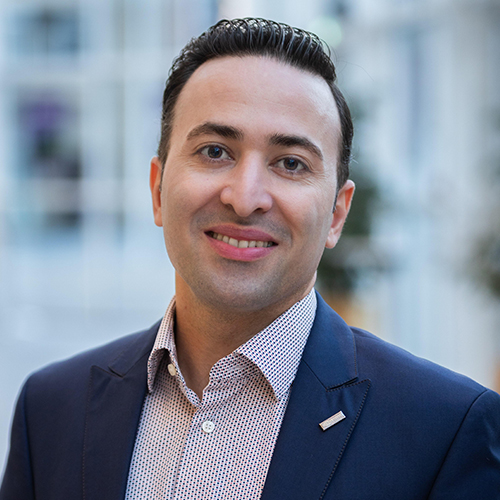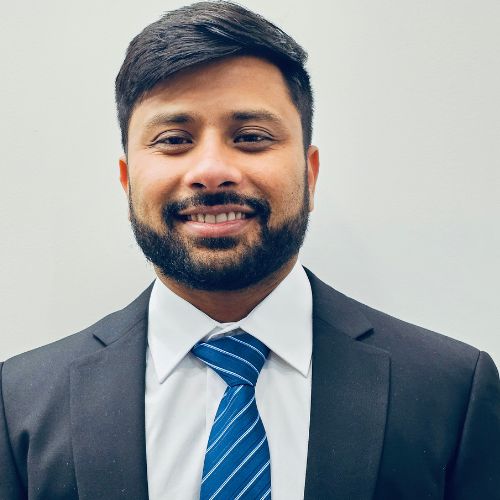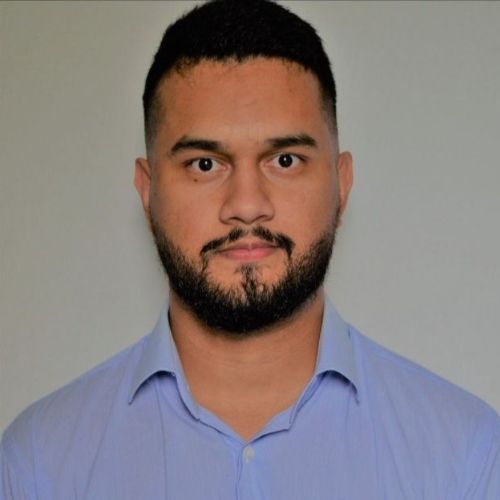IEEE IES-SYPA
SYPA ISIE 25 – Approved Finalists
Andre Ivann Herrera Chavez, Mexico
Paper ID: ISIE25-000026
Title: Hybrid Perception Loss-Driven Synthetic Images Generation of Pathological
Myopia Stages
Pablo Vicente-Torres, Spain
Paper ID: ISIE25-000302
Title: Modular Multilevel Serial-Parallel Converter (MMSPC) for the Tokamak SMART
William Moreira, Brazil
Paper ID: ISIE25-000295
Title: Evaluation of Classical and Reinforcement Learning Controllers for Motor Drives
Nasir Ali, Canada, McMaster University
Paper ID: ISIE25-000242
Title: A New Fault-Tolerant Three-Level T-Type Converter for SRM Drives in EVs/HEVs
Afraz Ahmad, Canada, University of Victoria
Paper ID: ISIE25-000096
Title: Design and Analysis of a Triple Active Bridge Converter for Simultaneous Charging
of Two Different EV Batterie
Sana Zahid, Canada
Paper ID: ISIE25-000102
Title: Data-Driven MPC for Trajectory Tracking Control of Wheeled Mobile Robots
Chengsong Yao, Japan
Paper ID: ISIE25-000141
Title: Redesign and Subjective Evaluation of a Wearable Neck Support Device for
Overhead work
Valeria Juarez Casildo, Mexico
Paper ID: ISIE25-000203
Title: Indirect Electrification Through Hydrogen: Evaluating Distributed Generation for
Fuel Cell Vehicle Autonomy
Juan Ramos Delgado, Spain
Paper ID: ISIE25-000300
Title: Evaluation of PWM Methods for Two-Level Voltage Source Inverters considering
Efficiency, Power Losses Distribution and Harmonic Performance
Leonardo D. Medina-Madrazo, Mexico
Paper ID: ISIE25-000073
Title: Three-Dimensional Measurement through the Calibration of a Laser Profilometer
Prarthana Pillai, Canada, University of Windsor
Paper ID: ISIE25-000166
Title: Real-time State of Power Estimation of a Lithium-Ion Battery Using Novel Battery
Observation Model and the Recursive LS Filter
Amir Kermanizadeh, Canada, Concordia University
Paper ID: ISIE25-000164
Title: Induction Motor Temperature Prediction via Transfer Learning on Physics-Based
Synthetic Data Using Deep Neural Networks
Soroush Naeiji, Canada, Simon Fraser University
Paper ID: ISIE25-000050
Title: Advanced Condition Monitoring of Metal Oxide Varistors (MOVs) in DC Circuit
Breakers Using Unsupervised Machine Learning Methods
Avishek Munsi, India
Paper ID: ISIE25-000136
Title: Design and Implementation of Wireless charging Infrastructure for Autonomous
Drone Charging
Hamid Jafarabadi Ashtiani, Canada,
Simon Fraser University
Paper ID: ISIE25-000048
Title: Deep Learning Based Cybersecurity Enhancement Strategy in Microgrids
IEEE IES STUDENTS AND YOUNG PROFESSIONALS PAPER ASSISTANCE PROGRAM (IES-SYPA)
The Student & Young Professionals (S&YP) Activity Committee of the Industrial Electronics Society (IES) is continuously implementing a paper assistance program (IES-SYPA) – competition-based financial support for the IES S&YP members to attend IES Majority Sponsored Conferences. For the ISIE’2025 we will provide 20 IES-SYP awards from 600 to 1500 USD each**, which can be used to cover the transportation costs to the venue city and back using the most economical means of transportation, participation fee, and accommodation in a hotel not higher than 3-star-class. More information is attached below.
Moreover, during the conference, we will organize a SYP forum – a special event aimed at helping students and young professional members stay connected in the IES community. The SYP forum will provide a unique opportunity to ask questions and get professional advice directly from IEEE Fellows, the IES President, AdCom members, and experienced colleagues. The program of a SYP forum will include a series of keynote speeches by the leaders of academia and industry, a 3M video session, and an open discussion between the participants. We encourage all conference participants to join!
Keynote Speakers

Professor Amjad Anvari-Moghaddam
Department of Energy (AAU Energy), Aalborg University
Keynote: From Transition to Transformation: The Future of Energy Systems and Markets
Bio
Amjad Anvari-Moghaddam (S’10 -M’14 -SM’17) is a Full Professor and Leader of Intelligent Energy Systems and Flexible Markets (iGRIDS) Research Group at the Department of Energy (AAU Energy), Aalborg University where he is also acting as the Vice-Head of Department (Research) and the coordinator of Integrated Energy Systems Laboratory (IES-Lab). His research interests include Planning, Control and Operation Management of Microgrids, Renewable/Hybrid Power Systems and Integrated Energy Systems with appropriate market mechanisms. He has (co)authored more than 300 technical articles, 7 books and 17 book chapters in the field. Dr. Anvari-Moghaddam serves as a Member of Council for Energy Efficient Transition at the Danish Ministry of Climate, Energy and Utilities, a member of Reference Group 5 “Climate, Energy and Mobility” for Horizon Europe (HE) at the Danish Agency for Education and Research (UFS), a Board Member of Energy Mission at Aalborg University, and the Chair of IEEE Denmark Section. Additionally, he holds the position of Editor-in-Chief for Academia Green Energy journal and has served as Associate Editor for several leading journals such as the IEEE Transactions on Power Systems, IEEE Systems Journal, and e-Prime Elsevier. He is an active member of IEC Standardization Subcommittees 8B-WG3, WG6 & WG8 as well as the European Committee for Electrotechnical Standardization (CENELEC/SR-73, TC-8X, TC-95X & SR-120). Furthermore, he has contributed as a technical committee member to various IEEE PES/IES/PELS and CIGRE working groups. He was the recipient of 2020 and 2023 DUO–India and SPARC Fellowship Awards, DANIDA Research Fellowship grant from the Ministry of Foreign Affairs of Denmark in 2018 and 2021, IEEE-CS Outstanding Leadership Award 2018 (Halifax, Nova Scotia, Canada), and the 2017 IEEE-CS Outstanding Service Award (Exeter-UK).
Abstract
The energy landscape is changing rapidly with far-reaching implications for the global energy industry and actors. While the transformation of the energy system is rapid in certain regions of the world-such as Europe, the speed of the global energy transition remains highly uncertain and there exist a number of socio-technical challenges yet to be solved. Harvesting renewable energies implies decentralization, where many consumers also become producers, who at times export electricity to the grid. To accommodate large numbers of renewable resources, energy distribution and transmission networks need to be adapted and expanded to avoid network congestion and failures. Flexibility options and services have to be also enabled not only at the supply side but also through responsive loads and suitable means of energy storage to maximize the security of supply and the quality of service in the most efficient way. Accelerating the energy transition also requires a rethinking of electricity markets in many aspects, a key one being the adaptation of their design and operation to support higher shares of variable renewables as well as distributed power generation. This talk covers the aforementioned promising areas in green energy transition and discusses the current and future opportunities and challenges exist in this context.

Dr. Akash Samanta
Postdoctoral Fellow, Ontario Tech University
Keynote:Harnessing Research and Innovation to Build a Better Future
Bio
Akash Samanta (Student Member, IEEE) received the B.Tech. degree in Electrical Engineering from the West Bengal University of Technology, India, in 2012, and the M.Tech. degree in Electrical Engineering and the MBA. degree in Energy Management from the University of Calcutta, India, in 2018 and 2014, respectively. He is currently a Postdoctoral Fellow in the Department of Electrical, Computer, and Software Engineering at Ontario Tech University, Oshawa, ON, Canada. His research interests include electric energy storage systems, battery management systems, power electronic converters, and the application of digital twin technology, cloud computing, and machine learning in these fields.
Abstract
In a rapidly evolving technological landscape, the ability to transform research into real-world innovation is more critical than ever for shaping a sustainable and impactful future. This keynote will highlight the essential role that young researchers play in driving technological advancement and societal change. Drawing from his journey across academic research, industrial collaboration, and technology transfer, Akash Samanta will share key strategies for leveraging curiosity, resilience, and innovation to build a successful and meaningful career. The talk will cover lessons learned from research commercialization, building industry partnerships, fostering startup initiatives, and navigating career development beyond academia. Through real-world examples and actionable insights, this session aims to motivate and empower the next generation of innovators to turn their ideas into lasting impact.
SYP Forum Chairs:

Dmitri
Vinnikov
Estonia

Edivan Carvalho
Estonia

Joao Carvalho Neto
Brazil
Local SYP Forum Chair:

Chathurika S. Wickramasinghe
USA

Anindita Golder
Canada

Latha Anekal
Canada

How to Apply:
- You MUST be an IEEE member. Whether Student, Graduate Student or Young Professional (YP). You are considered YP up to 15 years after your graduation.
- You MUST be a member of the IEEE Industrial Electronics Society.
- You MUST have a paper accepted at the conference as an author or co-author and be the person to present it at the conference.
- You MUST reside outside the city in which the conference is held.
- Your paper should be fully registered.
- You SHOULD NOT have received the SYPA in the last 2 years.
- In the submission system, if you toggled the correct membership (Student or YP), the “IEEE-IES SYPA” tab will appear once the paper is accepted. Click on that and submit the required information/document/video.
- You MUST prepare a video and send it according to the following rules:
- The length MUST be 3 minutes. Even 1 second more or less is not tolerated.
- Avoid using PowerPoint slides for most of the video. Only up to 30% of the video (1min) can be from the presentation slides. Be creative and generate interactive content! Watch more videos to get ideas.
- Some seconds MUST be devoted to the paper information such as title, authors, affiliations, your university, company, research team, etc.
- At least the last 5 seconds MUST contain the Acknowledgment to IEEE IES for the IES-SYPA!
- The video MUST be shared through sharing websites like Dropbox, Google Drive, OneDrive, etc. Make sure to provide the link without requiring permission (MUST be viewable to anyone who has the link)
Once your paper is accepted, the IEEE-IES SYPA tab will appear, and you can apply for it as:

Ensure you have turned on the required membership options in your profile at the top-right corner of the submission system. You should be an IEEE and IES member and also a student or Young Professional.

For any questions regarding the SYPA application submission issues, please contact the conference support team directly at conferences@ieee-ies.org
Review Process:
The committee members will review videos in 2 rounds. All applicants will be given one chance to update their videos according to the 1st-round comments. Then, the final video will be reviewed in 2nd-round and receive an average score based on its impact, creativity, style, presentation, video quality, etc. The ones with the highest scores from both paper and video reviewers will be selected as the winners of the IES-SYPA. They will receive financial support for travel expenses and a diploma during the Gala dinner.
The winners’ videos will be uploaded on the IES YouTube Channel, and you will receive an email including the link to your video on the IES YouTube Channel. You should copy that link to the IES Facebook Event page of the conference and wait for the thumbnail to appear, then post it!
Moreover, you should similarly post the link of your video to the IEEE Collabratec. You are also allowed to share it on any other websites. The direct link to the Facebook event page and IEEE Collabratec Group will be sent in the same email and will be available on the conference website.
Timeline
IES SYPA Application submission deadline
May 18, 2025
1st-round general comments on the videos will be sent by
May 22, 2025
Submission of the final 3-minute video
May 26, 2025
Announcement of winners
May 31, 2025
To Receive the Travel Assistance
- You MUST be on the list of final SYPA recipients.
- You MUST attend the conference and give 3-minute speech during the 3-Min Video Session.
DO NOT FORGET to bring your video file to the 3M Video Session. The videos will be displayed on a large screen, and you will talk to the audience for 3 minutes. So, your speech should be very brief and informative.
All information (including the place, date, and time) for the 3M Video Session and the ceremony to receive the Diplomas will be announced by the first day of the conference.
The fund can cover your expenses, including conference registration, transportation, and accommodation. So, keep your receipts and use the Concur platform to submit the expenses and other required information. All instructions can be found on the SYPA page of the conference.
It should be noted that if many applicants have obtained a high score, the committee can reduce the travel assistance amount to 1000 USD per applicant. This exceptional measure is to support the travel of a higher number of excellent applicants.
Some tips to prepare your video
- The 3M video session aims to help researchers/engineers (students and young professionals) learn how to advertise their projects to the public and promote the authors. Whether your work is theoretical or by simulations, you are expected to prepare the movie as interactive, live, and interesting for the viewers. Record some minutes from running results in the software during simulation or practical tests.
- Record some videos from your hardware design or even software results (e.g., the screen of your computer) while they are running. Or add some discussion with co-authors, research team, etc. At least 70% of your video should include interactive parts rather than solid slides.
- It is recommended that you present the work with your own voice during the video recording. Please present it in a different way than a PowerPoint presentation. Your video will be placed on the IES YouTube Channel and should attract viewers.
- Showing some information on the video using simple texts as subtitles is also recommended. Note that the voice is helpful for YouTube viewers; however, during the conference, it will be replaced by your 3M speech. The video may be displayed without sound during the S&YP 3-Min Video Session.
- Sometimes, background music could make your video much more enjoyable.
- The audience already saw your paper presentations, so be different in your videos.
- Try to make people interested in your videos. Devote some seconds of the video to your office, lab, or any place you work in and show the stuff you use for that project, introduce co-authors and supervisors, explain motivation, etc.
- The 3M video does not need to show the details of your work. Some concepts are enough to attract people’s attention. Deep theoretic and mathematics are useless for advertising your project to people with different interests.
- Note that the video should be impressive and interactive. Static pictures interest only some. Find gifs or flash images from the Internet.
- Ensure you have the copyright for materials used in your video, including animations, songs, photos, etc.
You can watch a good example of a 3Min video recorded at MIT here.
https://www.youtube.com/watch?v=inX07rt1kgU
Take a look at other videos posted by young researchers (young professionals and students) for the IES-SYPA at the following links: